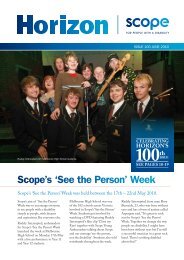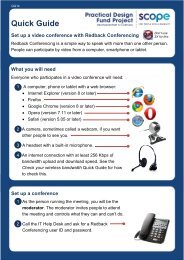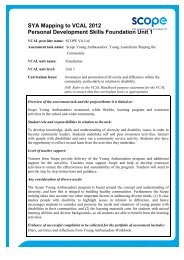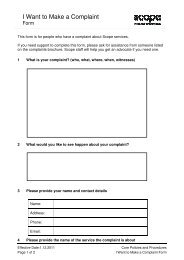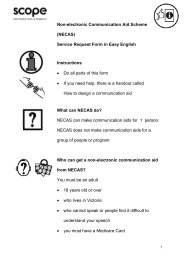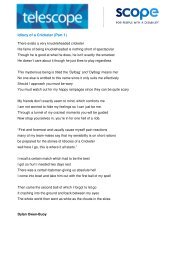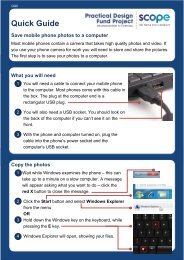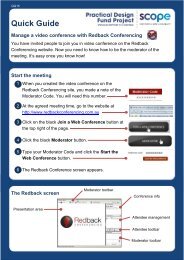Positive behaviour support Getting it right from the start
Positive behaviour support Getting it right from the start
Positive behaviour support Getting it right from the start
Create successful ePaper yourself
Turn your PDF publications into a flip-book with our unique Google optimized e-Paper software.
<strong>Pos<strong>it</strong>ive</strong> <strong>behaviour</strong> <strong>support</strong>: <strong>Getting</strong> <strong>it</strong> <strong>right</strong> <strong>from</strong> <strong>the</strong> <strong>start</strong> - Facil<strong>it</strong>ators reference manual 45<br />
PowerPoint 64<br />
*<br />
• Increase <strong>the</strong> rate of providing choices and o<strong>the</strong>r communication opportun<strong>it</strong>ies to people<br />
w<strong>it</strong>h complex communication needs.<br />
• Respond to all attempts at communication made by <strong>the</strong> person. Be sure to update <strong>the</strong><br />
person’s personal communication dictionary regularly.<br />
• In<strong>it</strong>iate and expand on any social or communicative <strong>behaviour</strong> made by <strong>the</strong> person,<br />
this will help <strong>the</strong> person learn new skills over time.<br />
Describe <strong>the</strong> expressive language of <strong>the</strong> person you are <strong>support</strong>ing.<br />
Describe <strong>the</strong> receptive language of <strong>the</strong> person you are <strong>support</strong>ing.<br />
Describe any form of AAC system your client uses or relies on.<br />
PowerPoint 65<br />
*<br />
Communication development<br />
Pre-requis<strong>it</strong>es for intentional communication<br />
From <strong>the</strong> time we are born we are developing <strong>the</strong> skills or pre-requis<strong>it</strong>es for intentional<br />
communication. In<strong>it</strong>ially our communication is unintentional and consists of crying when we<br />
are uncomfortable or hungry and our parents have to interpret what we want. As we develop,<br />
so does our abil<strong>it</strong>y to understand our environment and <strong>the</strong> power our <strong>behaviour</strong>s or actions<br />
have on those around us – The power of intentional communication.<br />
While our first words are often not spoken until about 12 months, we have already developed a<br />
number of skills and are clearly communicating.<br />
To get to <strong>the</strong> point where we are communicating intentionally we have to develop certain<br />
cogn<strong>it</strong>ive skills or pre-requis<strong>it</strong>es skills. These cogn<strong>it</strong>ive pre-requis<strong>it</strong>e skills to intentional<br />
communication are:<br />
• Being able to pay attention<br />
To learn about <strong>the</strong> world around us we need to be able to attend to <strong>the</strong> stimulus that is<br />
occurring; not only visually, but through all our senses of hearing, taste, touch and movement.<br />
• Understanding cause and effect<br />
Cause and effect is an important skill for communication development as we begin to learn<br />
that our <strong>behaviour</strong>s/actions have an effect on <strong>the</strong> objects and more importantly people<br />
around us. The key to communication is I do or say something and <strong>the</strong> o<strong>the</strong>r person will react<br />
in some way, hopefully w<strong>it</strong>h what I wanted.<br />
• Understanding object permanence<br />
Object permanence is <strong>the</strong> term used to describe knowing that something still exists even<br />
though we cannot see <strong>it</strong>. Having developed <strong>the</strong> skill of object permanence means that a<br />
person can communicate about things <strong>the</strong>y cannot see as <strong>the</strong>y realise that <strong>the</strong>y still exist.<br />
People w<strong>it</strong>hout an understanding of object permanence may only communicate about<br />
concrete things <strong>the</strong>y can see in <strong>the</strong> here and now.



